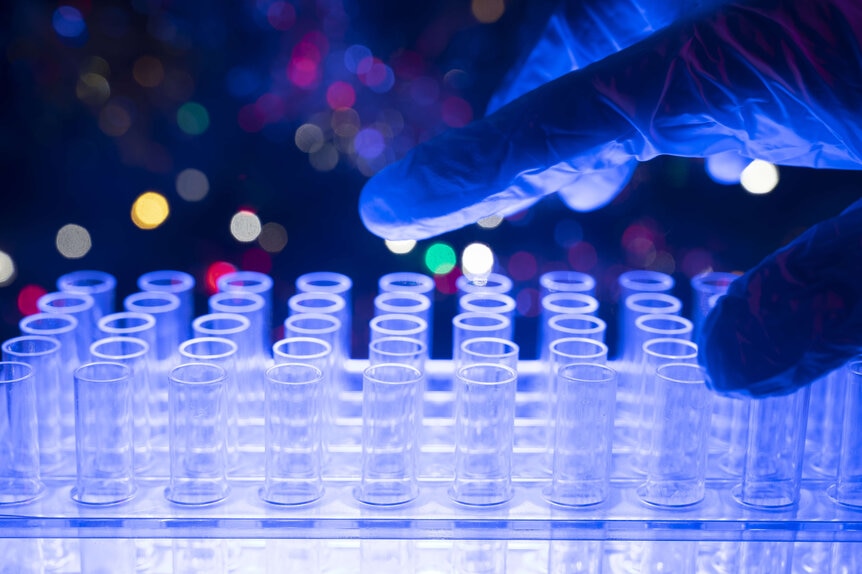Create a free profile to get unlimited access to exclusive videos, sweepstakes, and more!
Are No Time to Die's designer diseases possible in real life? The science behind Bond

No Time to Die may have been Daniel Craig's final appearance as James Bond, but it introduced new characters and a terrifying new type of warfare — a weapon that could find its way to the real world with insidious implications.
**Spoilers ahead for No Time to Die**
No Time to Die presents James Bond with a weapon he can't outsmart. Safin (Rami Malek) has obtained access to a novel biological weapon, nanobots which act like a virus, spreading from person to person. They don't kill or even make ill everyone they infect. Instead, they spread until they reach their target, having been programmed to the DNA of a specific person or persons.
It's a wicked type of weapon in the way it makes unwitting accomplices of ordinary people as they carry the disease and pass it along. Nanobots are a favorite of genre fiction for the way they can seemingly do just about anything from making new kinds of form-fitting armor to dismantling people or objects at an atomic level. To date, nanobots don't have anywhere near that sort of functionality. This type of targeted bioweapon, however, might be much more possible as a virus.
BIOWEAPONS
Bioweapons are nothing new. They've been around just about as long as warfare has existed, which is to say a long time. Methods of the past lacked the sort of evil elegance which is possible today, but they weren't any less effective.
Nearly a thousand years ago, Emperor Barbarossa poisoned well water with human corpses. A couple of centuries later, Mongols catapulted plague-infected bodies over the walls and into the Black Sea port in modern-day Ukraine. It's possible ships from that port returned to Italy with the pathogen, jumpstarting the Black Death in Europe, killing millions. European colonists infected indigenous peoples with smallpox through contaminated blankets. Poisons have been used to assassinate individuals since the beginning of recorded history.
The use of biological agents as weapons is so ubiquitous there are animals, like poison dart frogs, who derive their names from the way we've co-opted them as weapons. However, biological warfare is, sadly, not a thing of the past.
The development and use of biological weapons continued through the world wars and the cold war until the enforcement of the Biological Weapons Convention (BWC) treaty in 1975. Even still, the Soviet Union continued developing biological weapons until its fracturing in 1991.
Today, officially, there are no ongoing biological weapons programs in any of the 190 countries that are signatories to the BWC, but that's difficult if not impossible to validate. There are no verification procedures in place and the nature of biological weapons development is such that it can be done relatively easily, inexpensively, and in secret with materials present in labs all over the world.
As our understanding of pathogens evolved, so too did our ability to develop biological weapons. Now, with the advent of genetics and technologies like CRISPR and other gene-modifying tools, a whole new class of biological weapons is possible.
GENE-SPECIFIC WEAPONS
One of the biggest barriers to crafting bioweapons is access to dangerous pathogens. Pathogens like smallpox are wisely well-protected and exceedingly difficult for researchers to get their hands on. The ubiquity of genetic technologies could overcome those barriers.
In a July 2002 paper published in the journal Science, researchers were able to synthesize the Polio virus from scratch following the known genetic recipe as guidance. This opens up the possibility of reconstituting extinct or uncommon pathogens for use as weapons, or altering existing pathogens to make them more deadly, more transmissible, or resistant to existing treatments. This too was completed by the Soviet Union when they modified anthrax making it resistant to vaccines.
So far as we know, no bioweapons have been developed to target specific genetic markers but the possibility has caused worry enough to spark conversation among government officials, at least as far back as 1997. A Department of Defense news briefing from April of that year includes the following conversation: “There are some reports, for example, that some countries have been trying to construct something like an Ebola Virus, and that would be a very dangerous phenomenon, to say the least. Alvin Toffler has written about this in terms of some scientists in their laboratories trying to devise certain types of pathogens that would be ethnic specific so that they could just eliminate certain ethnic groups and races.”
Thousands of viruses have been sequenced, with many of their genomes available to the public online. As sequencing and technology advance and become more affordable, one can imagine how a pathogen might be devised by taking an existing disease and reconfiguring it to favor infection of individuals with specific genetic markers. And there is some research to suggest that could be possible relatively soon.
If it's happened already, no one is publishing papers about it. Such a pathogen would be devastating in its ability to preferentially impact individuals across ethnic lines. The same technology could potentially be taken to an extreme, targeting not ethnic markers but unique individual ones.
A fictional article from The Atlantic outlined a process by which a disease might be constructed, using gene therapy and crowdsourcing, to target a political leader. The larger question perhaps, is why bother? Existing weapons, whether biological, kinetic, or otherwise, are effective enough as they exist today. Crafting a designer disease seems like an awful lot of work for a single individual, especially when other methods exist. Of course, humanity might be best served by getting out of the business of killing one another altogether. Barring that, we should probably quit inventing new ways to do it. Viruses do enough damage without our help.
















